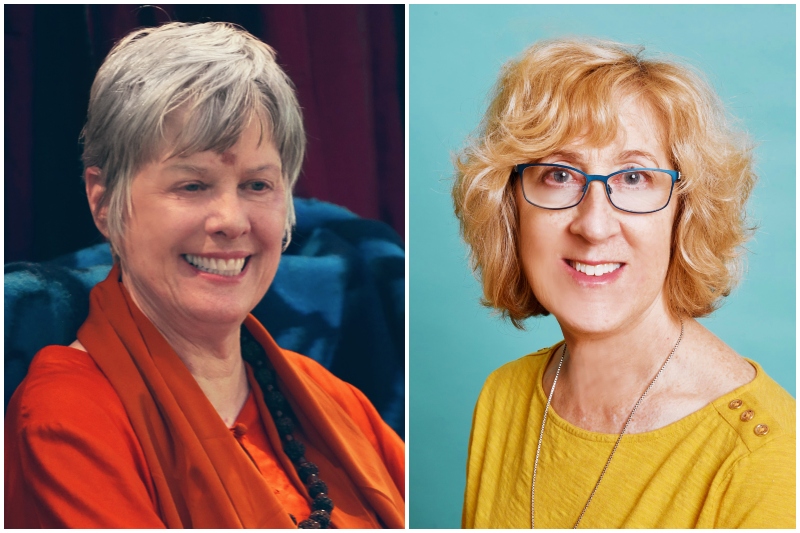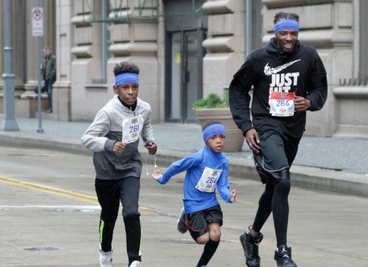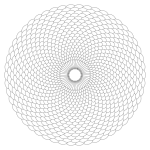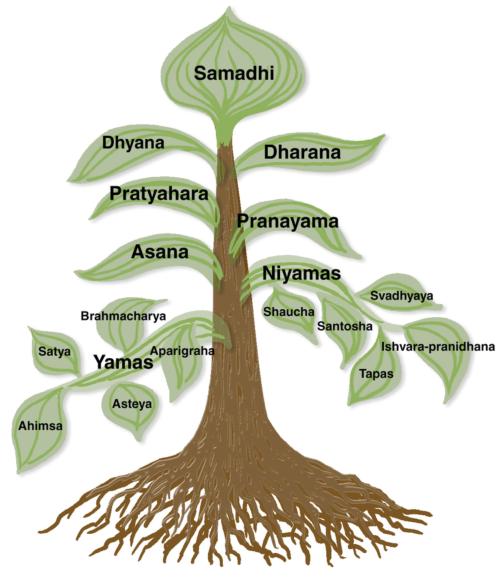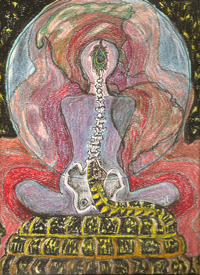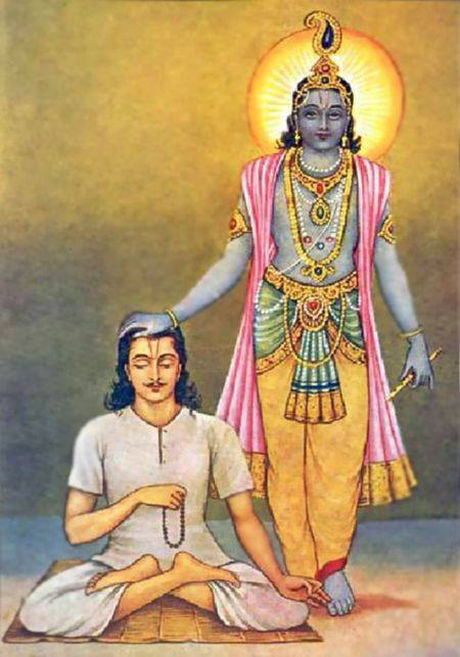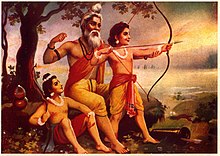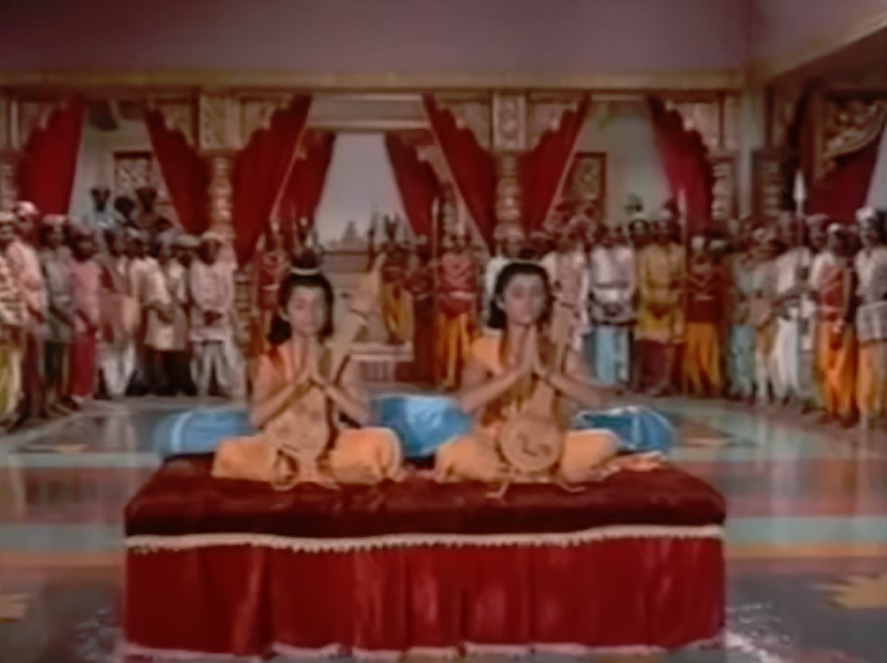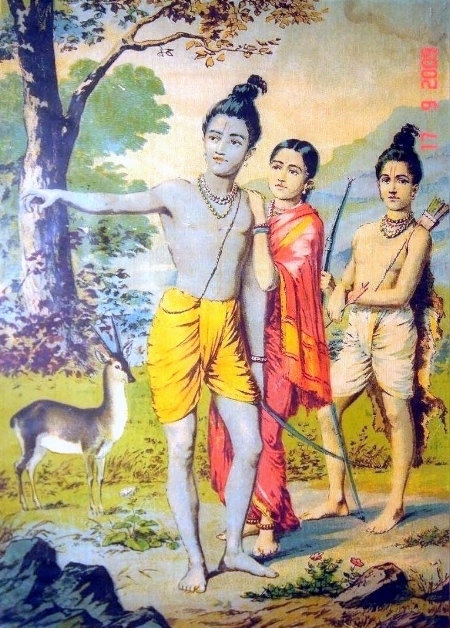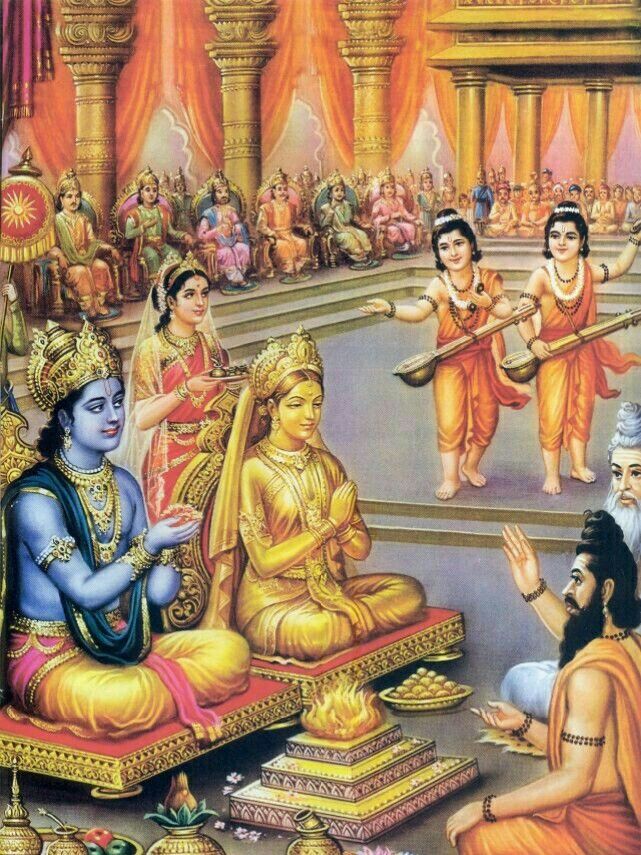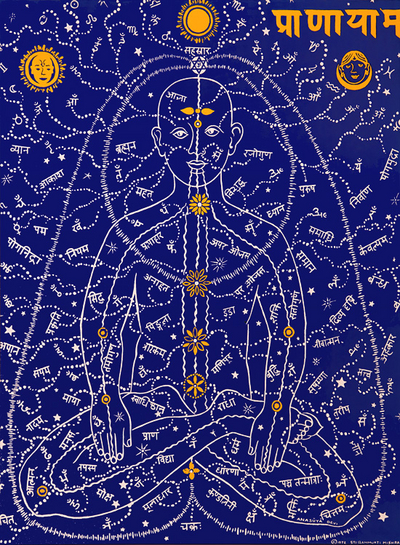 By Nirooshitha Sethuram
By Nirooshitha Sethuram
Sita is living in Valmiki’s forest Ashram while Lord Rama, her husband, is performing the Ashvamedha yaj~na to benefit his kingdom and all the people in it.
The yajna horse wandered around the land unchallenged, ending up near Valmiki’s ashram on its way back to Ayodhya. Lava and Kusha found out about Rama’s horse from their friends, so they caught the horse and tied it to a tree nearby, specifically so their mother would not know about it. Lava stayed to guard the horse with a few friends while Kusha went to get the flowers for his mother’s puja.
Shatrugna and his army followed the horse, arriving at the Ashram. The guards at the front of the group were surprised to see the horse held captive by acetic children. They thought the kids were playing a joke, advised them not to interfere in royal business and went towards the horse to untie it. An arrow from Lava’s bow landed right in front of the guard’s feet. The guards fought back, but were defeated in a minute. They ran to Shatrugna.
Shatrugna came over and found Lava and his friends. Shatrugna was amazed that an ascetic child defeated the guards. Thinking the guards had been fooled, Shatrugna politely asked the children to release the horse. However, they were very serious about the matter and refused to do so. Not knowing the powers they had received from their Guru Valmiki, Shatrugna challenged them to a battle for the horse. He and the rest of the Ayodhya army were defeated instantly by Lava.
The news about Shatrugna’s defeat reached the palace, as well as the fact that Shatrugna, the army and the horse were in captivity. Lakshmana rounded up the rest of their troops and went there. He also found these lovely little boys, Lava leading them, and thought that Shatrugna must have made some mistake to end up in the fate he was.
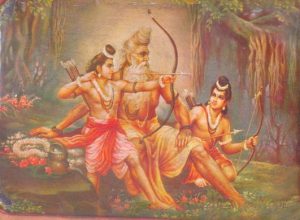 Thinking that these were just ascetic children, not knowing how Valmiki trained them for battle, Lakshmana started talking to them, asking them to release the horse and his brother Shatrugna.
Thinking that these were just ascetic children, not knowing how Valmiki trained them for battle, Lakshmana started talking to them, asking them to release the horse and his brother Shatrugna.
When Lava realized it was Lakshmana speaking, he condemned Lakshmana for leaving a pregnant woman (Sita) in the forest without any help. As usual, everyone knows Lakshmana is very short tempered. Thus, the peace talks didn’t last long. The battle between Lava and Lakshmana began. Lava fought bravely and bound all the troops Lakshmana brought.
Unable to withstand Lava’s skill, Lakshmana used his “Nagastra” (arrow of the cobra) to tie him up. Lakshmana carried Lava to the chariot, preparing to liberate the horse, Shatrugna and the army. The other children escaped, taking the news to Kusha, who was just returning from gathering flowers for Sita. Kusha immediately jumped in front of Lakshmana. stopping him from liberating the horse. He demanded that Lakshmana free Lava.
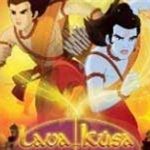 Lakshmana advised Kusha not to make the same mistake his brother had made by confronting him. Kusha invited him to a battle to settle the matter. The fight was intense. It was a desperate situation, needing to free his brother, so Kusha used one of the special arrows given by his Guru Valmiki, by which he was able to defeat Lakshmana. Then Kusha unbound Lava and imprisoned Lakshmana. Then the twins sent one of warriors to inform Rama what had transpired.
Lakshmana advised Kusha not to make the same mistake his brother had made by confronting him. Kusha invited him to a battle to settle the matter. The fight was intense. It was a desperate situation, needing to free his brother, so Kusha used one of the special arrows given by his Guru Valmiki, by which he was able to defeat Lakshmana. Then Kusha unbound Lava and imprisoned Lakshmana. Then the twins sent one of warriors to inform Rama what had transpired.
The messenger came to Rama with the news. Rama was astonished that two ascetic children had defeated the mighty Ramarajya troops, and especially his brothers. He decided to go in person. As usual, accompanied by Hanuman, Rama arrived and found the two ascetic children were those who sang the Ramayana at the palace. Like his brothers, Rama tried to make peace by talking to them. They were not ready to listen, decisively refusing to release the horse. They called Rama out for a battle, saying he had no right to do the yaj~na without his wife Sita.
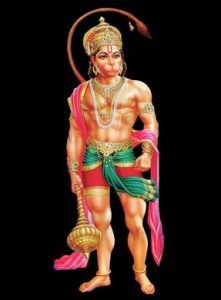 Watching all this, Hanuman took on his gargantuan form, saying they would have to go through him first to get to Rama. Knowing it is impossible to win a battle with Hanuman, Lava and Kusha said that it would be very easy and whispered to their friends to start the repetition of “Sri Rama.” All the other children started dancing and singing “Sri Rama.” In an instant, Hanuman came back to his normal form and started dancing and singing with the children. The children slowly moved towards the Ashram, Hanuman following them, dancing and chanting. Rama was amazed to see this happen, realizing the children were no simple matter. Yet he had no other option, so he resolved to fight with them. The fight began, Rama battling Lava and Kusha.
Watching all this, Hanuman took on his gargantuan form, saying they would have to go through him first to get to Rama. Knowing it is impossible to win a battle with Hanuman, Lava and Kusha said that it would be very easy and whispered to their friends to start the repetition of “Sri Rama.” All the other children started dancing and singing “Sri Rama.” In an instant, Hanuman came back to his normal form and started dancing and singing with the children. The children slowly moved towards the Ashram, Hanuman following them, dancing and chanting. Rama was amazed to see this happen, realizing the children were no simple matter. Yet he had no other option, so he resolved to fight with them. The fight began, Rama battling Lava and Kusha.
The children and Hanuman reached the ashram. Mesmerized, Hanuman came back to his senses, finding himself in Valmiki’s Ashram. Hearing the chanting of Mata Lalitha Devi’s mantra by a very familiar voice, he jumped up in joy, recognizing it as Sita’s. He ran into the puja, fell down at Sita’s feet, and shouted, “I found Sita Devi again, I found Sita Devi again…”
All the ascetics, who had been with Sita all these years, we astonished. Everyone fell at Sita’s feet. Suddenly Hanuman realized this was the area where he left Sita years ago, when the young sages found her. Putting everything together, it occurred to him that the twin children must be none other than Sita’s.
Hanuman trembled, thinking of the fight that was happening between father and sons. He explained what had happened in the past few days, between Rama’s yaj~na horse and the twins. He also told her about the battles that had taken place and the one now taking place. Sita was in the middle of a puja that should be uninterrupted, but realized the gravity of the situation. Even though the other ascetics tried to stop her, she ran out, asking Mata Lalitha Devi for forgiveness for the interruption in the puja.
Sita and Hanuman came to the battleground, seeing that Rama, as a last resort, had taken the “Ramaastra” in his hand to shoot it towards the twins. Sita shouted, “Stop!” Hearing the voice of Sita, Rama dropped his bow and arrow, looking at her and saying, “That is my Sita’s voice…”
Sita grabbed both Lava and Kusha, sobbing, “How could you take up arms against your father? It is all my fault!” Lava and Kusha were stunned by their mother’s words, and quietly asked, “Are you Rama’s Sita Devi?” Sita nodded her head and hugged them both.
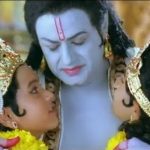 When she released them, Lava and Kusha fell on Rama’s feet, “Forgive us father! We have committed a crime by taking up arms against you, not knowing that you are our father. Please forgive us!” Rama said, “The crime was mine, banishing my beloved Sita from Ayodhya and being separated from her all this while, missing my children’s youth years.” He hugged both Lava and Kusha. Looking at the father and sons united, Sita was so happy. Rama asked Sita to come to Ayodhya with him.
When she released them, Lava and Kusha fell on Rama’s feet, “Forgive us father! We have committed a crime by taking up arms against you, not knowing that you are our father. Please forgive us!” Rama said, “The crime was mine, banishing my beloved Sita from Ayodhya and being separated from her all this while, missing my children’s youth years.” He hugged both Lava and Kusha. Looking at the father and sons united, Sita was so happy. Rama asked Sita to come to Ayodhya with him.
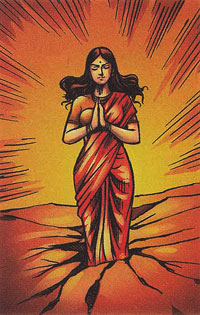 Refusing, she said she cannot come to Ayodhya again. Bidding farewell, she called upon her mother, Mother Earth, to take her into her arms if Sita is pure in her heart and has not lost her chastity. As soon as she uttered those words, the earth split open. Up came Mother Earth, took Sita in her arms and disappeared into the split earth. Unable to do anything to stop Sita, Rama, the twins and Hanuman cried their eyes out.
Refusing, she said she cannot come to Ayodhya again. Bidding farewell, she called upon her mother, Mother Earth, to take her into her arms if Sita is pure in her heart and has not lost her chastity. As soon as she uttered those words, the earth split open. Up came Mother Earth, took Sita in her arms and disappeared into the split earth. Unable to do anything to stop Sita, Rama, the twins and Hanuman cried their eyes out.
Everyone returned to Ayodhya with a very heavy heart. Rama conducted the Ashvamedha Yaj~na with Sita’s statue at his side, as planned. Lava and Kusha helped their father with the yaj~na. Slowly, by the Ashvamedha Yaj~na effects, Ayodhya started flourishing again. Now that the kingdom was getting back to its glory days, Rama started thinking about giving the kingdom’s rule to the children, both his and his brothers’.
One day while he was thinking about his plan, a guard announced that a sage was waiting to see him. Immediately, Rama ordered the guard to show him in. The sage came in and Rama offered him a seat. The sage said, with a little hesitation, you need to know who I am before you offer me a seat. Rama replied that whoever who visits, even if it is a foe, the first order of business is to extend hospitality.
After the greetings, the sage said that Lord Brahma sent him, and that they need to have a private meeting, with no one disturbing them. Immediately, Rama called upon Lakshmana to make sure no one disturbed them, to guard the door at all cost. As usual, taking Rama’s command, Lakshmana stood guard at the door.
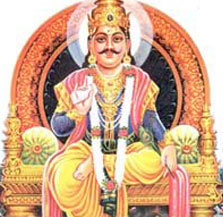 Inside, the sage revealed his true identity as Yama-Dharma-Raja, the God of Dharma in charge of ending lives (God of Death). He continued that he had been instructed by Brahma to give prior notice to avatars such as Rama about their return time approaching. He also pointed out that Shri Lakshmi Devi, who was with Rama as Sita in this world, had already returned to Vaikuntha, and that Rama needed to send Lakshmana, Bharata and Shatrugna before his own return.
Inside, the sage revealed his true identity as Yama-Dharma-Raja, the God of Dharma in charge of ending lives (God of Death). He continued that he had been instructed by Brahma to give prior notice to avatars such as Rama about their return time approaching. He also pointed out that Shri Lakshmi Devi, who was with Rama as Sita in this world, had already returned to Vaikuntha, and that Rama needed to send Lakshmana, Bharata and Shatrugna before his own return.
Outside, Lakshmana was guarding. The great sage Durvasa, son of Atiri, arrived, wanting to meet Rama to discuss an urgent matter. Lakshmana tried his best to calm him and have him wait, but Durvasa became very agitated. Knowing Durvasa to be both short tempered and powerful, Lakshmana knocked on the door hesitantly. He knew he was disobeying Rama’s order for the first time ever, but it was to evade sage Durvasa’s curse that would destroy Rama’s whole lineage.
The discussion between Rama and Yama-Dharma-Raja was coming to an end. Knowing that Lakshmana would not knock without a pressing need, Rama opened the door. Meanwhile Yama-Dharma-Raja again disguised himself as the sage who had entered earlier.
Lakshmana explained the reason he disturbed them, due to the visit of sage Durvasa. Thanking the sage (Yama-Dharma-Raja), Rama extended his hospitality to sage Durvasa. After sage Durvasa left, Rama sat down to consider how he could free himself from the Ayodhya kingdom. Sita had already gone. He didn’t need any other reason to complete his mission as avatar.
Rama came up with a plan to divide the country and give it to all 8 children, his and his brothers’, before leaving the earth. Rama called Lakshmana in and revealed the visit by Yama-Dharma-Raja. He explained that Lakshmana must go Vaikuntha before himself. Lakshmana jumped up, saying that the one thing guaranteed is that all who are born in this world have an exit day. He said that he hoped he wouldn’t have to wait long in Vaikuntha for Rama to arrive.
As Rama’s plan was being set in motion, the world around seemed to react. Kaushalya, Kaikeyi and Sumitra died one after the other, in very short intervals. All four brothers felt sad and starting talking about mothers. Lakshmana said he needed to clear the air, since people talked ill about Kaikeyi’s actions in the past. He said, “Our mother Kaikeyi’s actions, in sending our brother Rama to the forest, was to keep her husband Dasaratha’s promise to her own father Ashwapati. Ashwapati’s grandson must be the heir to the throne. Everyone has misunderstood her actions erroneously.”
Rama was happy that this fact, which he already knew, had been brought to light by Lakshmana for the world to know. After this, Lakshmana said his goodbyes to everyone. He went to the Sarayu River, dipped himself in the water and saw Indra come in his flying chariot to take him to Vaikuntha. Rama was devastated that Lakshmana was not with him anymore.
Dividing the country up and naming the rulers for each portion happened very quickly after. The news about Lakshmana’s departure and Rama’s planned departure spread like wildfire. The citizens of Ayodhya were there with Hanuman, who obviously never released Rama from his sight. Rama says that he will not take Hanuman with him. Instead Rama commanded Hanuman to be on earth as a chiranjivi (immortal), continuing to repeat Rama’s name. With tears in his eyes, the never disobeying Hanuman accepted Rama’s command, looking at Rama dipping in the Sarayu River to go to Vaikuntha. The children and Hanuman remained with a very heavy heart.
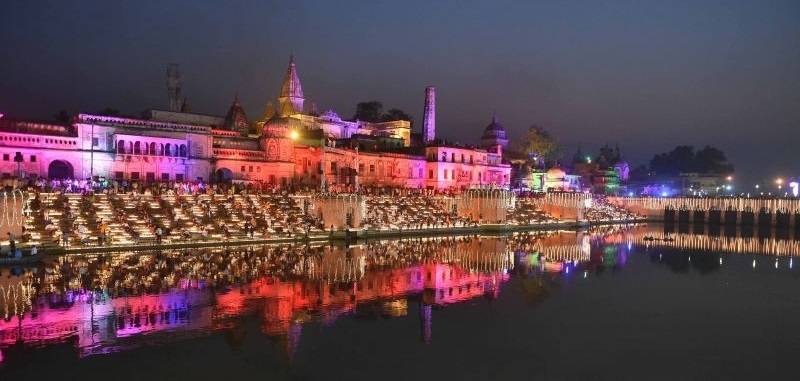
Sarayu River – Ayodhya (today)
It is said that Hanuman lives on this earth eternally. He will be at any and every place where the name “Rama” is spoken, even only once. If you are in trouble, all you need do is call out Rama’s name once and Hanuman will be there to take care of you. Jay Shri Ram!
Om Namah Shivaya
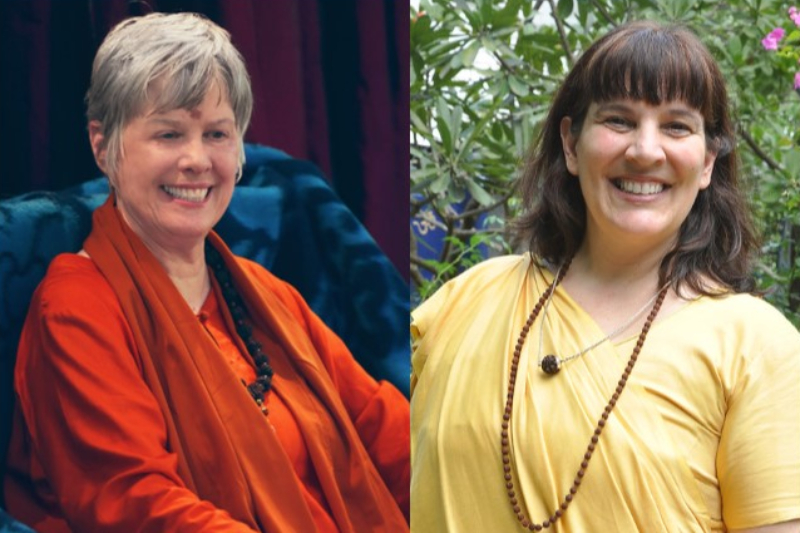 by Swami Nirmalananda Saraswati & Rukmini Abbruzzi
by Swami Nirmalananda Saraswati & Rukmini Abbruzzi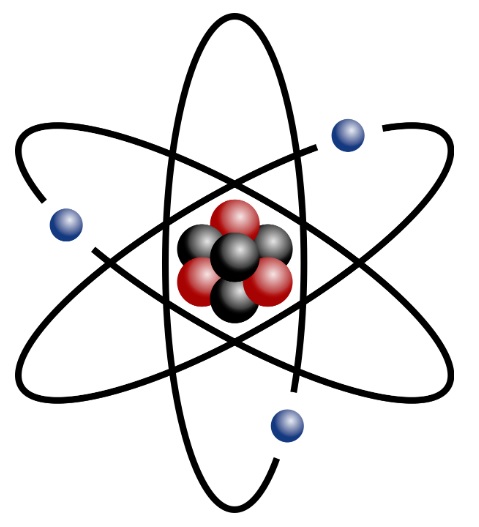 Physicists dedicate themselves to an outer exploration of this universe, down to the atoms and subatomic particles, yet they are finding common ground with poets and yogis, whose own exploration is an inner one. Our yogic tradition, Kashmiri Shaivism, explains how it is that the scientists, poets and yogis can arrive at the same place:
Physicists dedicate themselves to an outer exploration of this universe, down to the atoms and subatomic particles, yet they are finding common ground with poets and yogis, whose own exploration is an inner one. Our yogic tradition, Kashmiri Shaivism, explains how it is that the scientists, poets and yogis can arrive at the same place: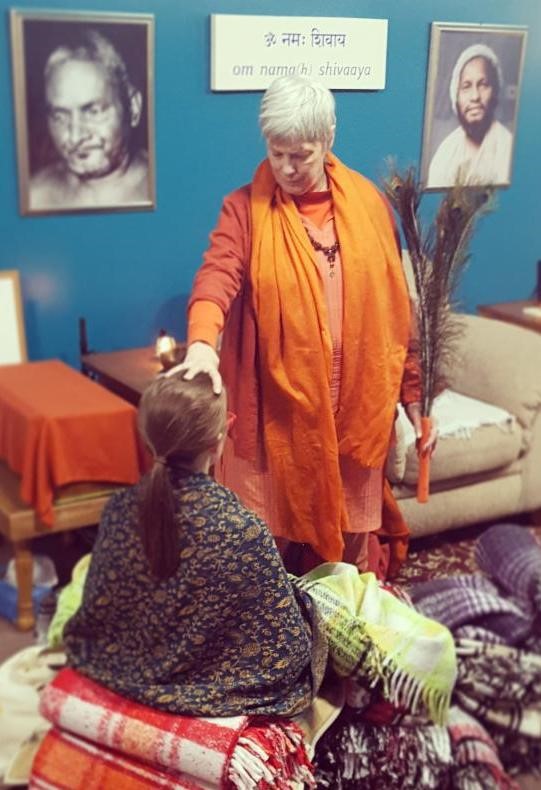 As a human being you have the unique ability to know the whole of Consciousness. In a Shaktipat (initiation) tradition like ours, these inner experiences open up so easily, which is the point of all the Svaroopa® sciences.
As a human being you have the unique ability to know the whole of Consciousness. In a Shaktipat (initiation) tradition like ours, these inner experiences open up so easily, which is the point of all the Svaroopa® sciences.

